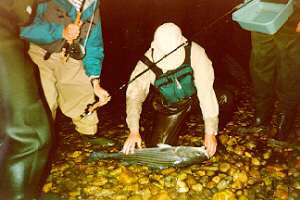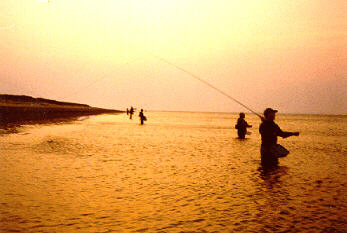
In 1996 I was fortunate to spend the last two weeks of May, and the entire month of June, fly rodding the waters surrounding Martha's Vineyard, an island off of the coast of Massachusetts, while working on the island at Larry's Tackle Shop in Edgartown. During my stay, I experienced some fine fly fishing on the sand flats in a few of the island's salt ponds. It was around the end of June that Lou Tabory visited the island, and caught some very nice fish on the flats as well. Later, Ruth Meyer, then owner of Larry's Tackle Shop, would tell me about a fly that Lou had shown to her; a weighted sand eel fly of his own design. When I returned to my home in western Massachusetts on the first day of July, I went back to the task of producing saltwater flies. On one of the days I spent experimenting, I came up with a weighted sand eel of my own, which I dubbed the Deep Sparkling Sand Eel.
This fly I made in several sizes and colors, and then stashed them away in anticipation of my return to Martha's Vineyard in September. When I returned to the island in the fall, I found that this pattern took fish quite well, both on the flats, and in deeper water, for the fly has a wonderful action in the water. When retrieved, it glides through the water for a short distance, and then sinks rapidly. This action seemed to appeal to stripers and other gamefish, which are always on the lookout for injured or disabled baitfish.
September is the month when False Albacore show up in island waters. It is also the month when the island's famous fall fishing derby starts. When I found out that I had the first day of the month-long derby off from work, I quickly tied a few more Deep Sparkling Sand Eels. I didn't want to be without the fly that had been producing so well, and I was sure that the false albacore would like it just as much as the striped bass.
The first day of the 1996 Martha's Vineyard Striped Bass and Bluefish Derby dawned gray with wind and rain, as a northeast storm blew its way down the New England coastline. At the Lake Tashmoo boat launch, I met Jim Malm, who had invited me to join him for a day on his boat, in search of the elusive bonito and false albacore. As we left the inlet to Tashmoo, and headed out into Vineyard Sound, I braced myself for a wet day of boat fishing. In this I would not be disappointed.
Jim and I searched the north shore of the island for an hour or more in vain, before deciding to head into Vineyard Haven harbor in search of shelter from the wind, which was growing stronger. We put into a local marina at Lagoon Pond in order to gas up the boat, and then stopped under the drawbridge at the inlet to the pond to try to pound up a few stripers around the pilings. Though a few fish were breaking around the bridge, the wind and waves spoiled our casts, and tangled our lines. I picked up a spinning rod to try to foil the breeze, but quickly became frustrated when I snagged the bridge on the first cast. Breaking off the jig with a sharp tug on the line, I turned to Jim and shook my head. "Let's get out of here", he said, and we decided that the day was a bust.
The wind had risen to about twenty-five knots, and now the rain was finding its way down the back of my neck, in spite of the full suit of foul weather gear I had donned back at the boat ramp. We turned the corner and motored out of the Lagoon. As Jim pointed the boat towards home, I spied a disturbance out of the corner of my eye.

In the shallow part of the harbor to our left, fish were blitzing in a foaming wave. "Albacore!" I shouted, and Jim turned and slowed the motor. "Get up there," he said to me as he worked the boat closer to the fish. I yelled back: "I can't cast in this wind!" The wind had now become so strong that we could barely hear each other. "Get up there!" Jim shouted again, so I stopped arguing, grabbed my fly rod, and positioned myself in the bow of the boat. The deck was slippery now with spray, and I braced myself against the rail as I struggled to work out line. Jim 's boat work was perfect as we drifted right up on the breaking fish. I made one quick cast into the blitz, and a fish boiled on the fly without taking it. I tried to keep my cool, and continued retrieving. Another boil, and then the fish ate the fly. "I'm on!", I shouted, and then we began a wet and wild ride as we chased the fish around Vineyard Haven harbor. After ten or fifteen minutes we had the false albacore at boatside. I had some trouble raising the fish at the end, but Jim finally slid the net under it, then we quickly rounded West Chop heading for home, smiling despite the cold wind and rain that had freshened from the northeast. At the tournament weigh-in that evening, my fish came in at just over ten pounds, and I took the lead for boat fly rod false albacore.
I held on to first place for a few days before being bumped down to second. During the second week of the derby, a gentleman came into Larry's Tackle Shop complaining of his lack of success with the false albacore. He had been finding fish, but not hooking up. "All I can tell you", I said, "is that I caught a nice fish on one of these", and I showed him the Deep Sparkling Sand Eel. Later that week he would return to boast about the false albacore that he had caught on a Deep Sparkling Sand Eel that he had tied. At the weigh-in, his fish would be heavy enough to knock me into third place! Within days, falling water temperatures would send the "albies" south to entertain fly rodders at Montauk, New York, and then on to the Outer Banks of North Carolina. With the false albacore gone, and my third place assured, I was free to turn my attention back to the stripers.
The month of October on the island of Martha's Vineyard is a time of change. The autumnal storms that herald the coming of winter also bring gamefish moving south on their fall migration. Soon I would return to my own "wintering grounds" in the mountains of western Massachusetts. In my office, a stone's throw from the Housatonic River, I would return to my bench to begin another winter's worth of tying. My efforts would surely include the Deep Sparkling Sand Eel, a pattern that would find a permanent home in both my memory, and in my fly box.
